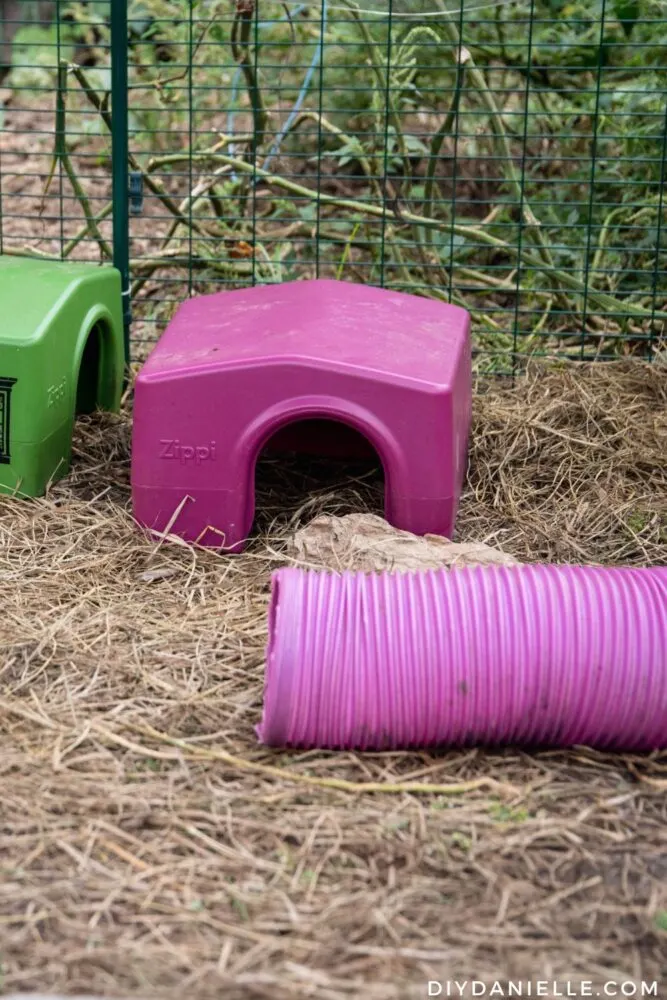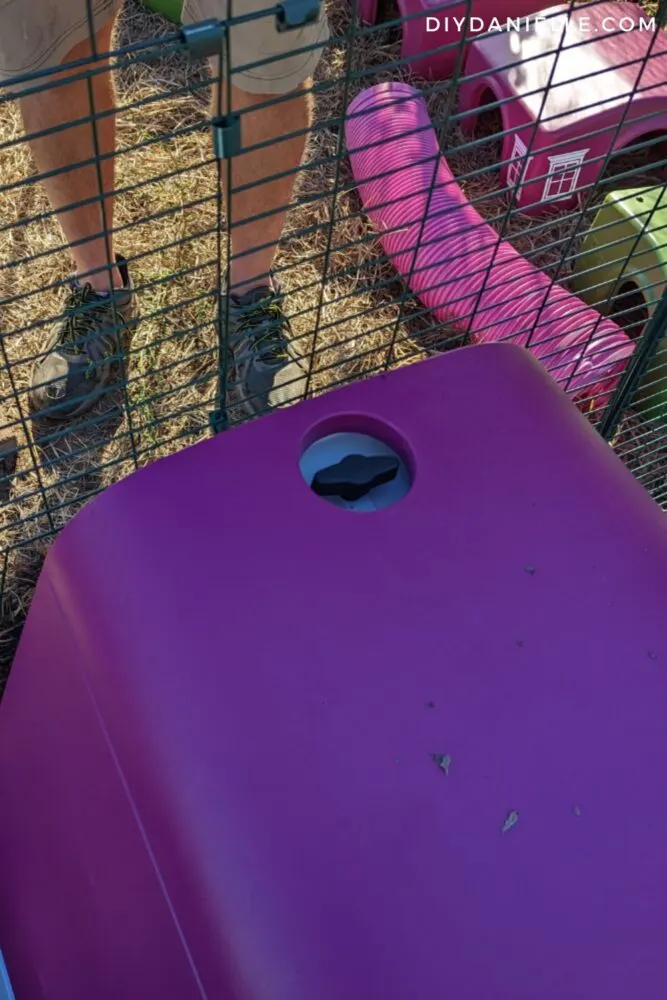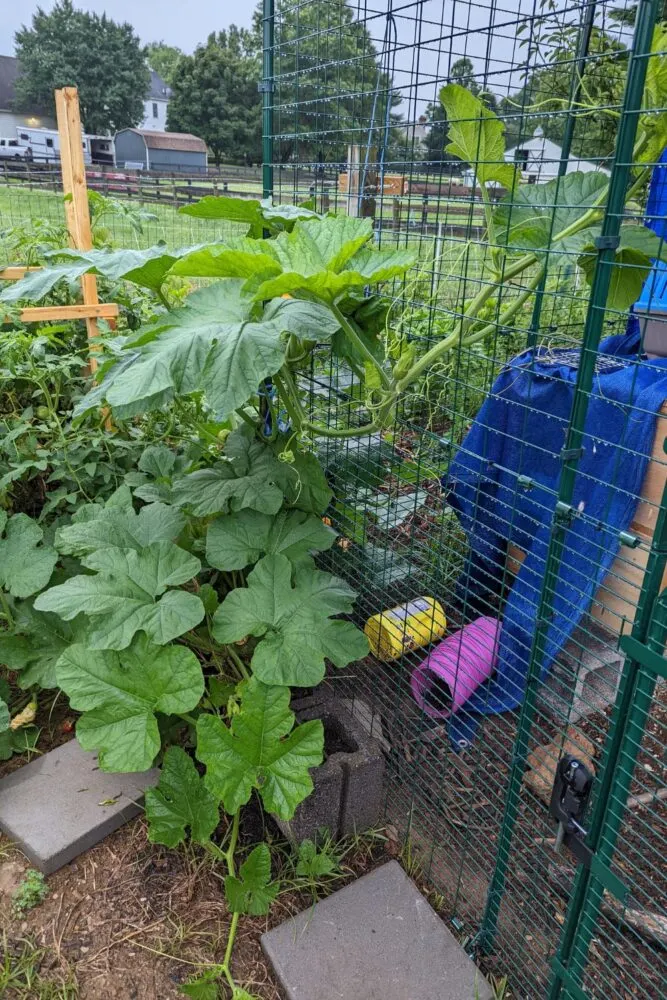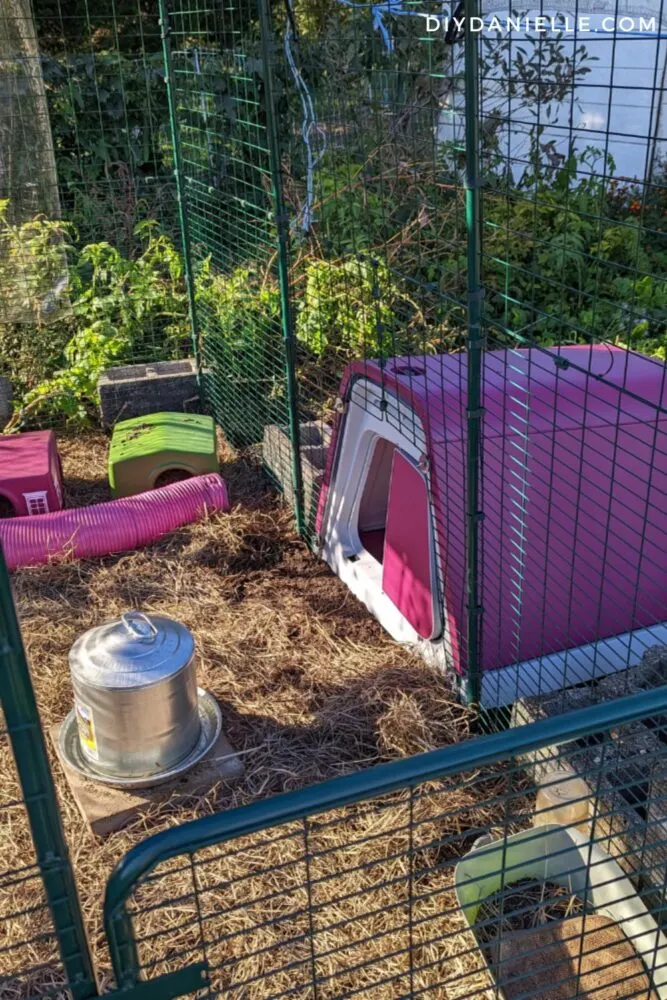A review of the Omlet Outdoor Guinea Pig Enclosure. This outdoor guinea pig hutch and run has plenty of room for a herd of cavies.
We’ve tried EVERYTHING for guinea pig housing. I started with a Midwest cage and a wood base. This worked well, but we upgraded because I wanted something that didn’t break my back when I cleaned it. I whipped up this taller guinea pig cage later on… I particularly love the little hay cubby at the end.
But I found that we didn’t spend as much time with the guinea pigs when they were living in the kids’ rooms. We don’t GO in their rooms that much and we spend a LOT of time outside.
So I started to explore the possibility of keeping the guinea pigs outdoors. We built a HUGE outdoor cage because I wanted to give our pets the MOST ROOM possible… at the time, we had the cage inside the enclosed chicken run so the guinea pig cage was protected by an additional fence.
This post may contain affiliate links which may earn me commissions should you click through them and take certain actions. As an affiliate for Amazon, Cricut, xTool, Home Depot, and other sites, I earn from qualifying purchases. Please DIY carefully. View my full legal disclosures here.
Please read the whole post so you don’t miss any important information!
Again though, I grew dissatisfied and seized the opportunity to change up our cages when we moved the chicken coop so we could put our new modular barn in that spot. I built a large two level guinea pig cage with clear front. That cage resided in a stall of the barn for a while, until I finally bought this outdoor guinea pig enclosure.
Our guinea pig enclosure resides inside my 60×70 garden which has no climb horse fencing surrounding it. On top of the no climb, I also have a chicken moat area around the garden that is fenced with electric fencing. This creates extra protection for the guinea pigs, and they also get lots of treats from the garden.
I think this is the cage we’ll settle on finally. We MAY upgrade the size, however, as I’d love to have a bit more space for them to run.
Omlet Outdoor Guinea Pig Run vs. Zippi Guinea Pig Run
The outdoor run is a different product that the Zippi run. The Zippi run is less permanent and better for temporarily setting up an outdoor playtime for your guinea pigs. The Outdoor Run is supposed to be more predator proof and better for long term use.
Honestly, I LOVE the add-ons for the Zippi run and the Zippi is also quite a bit less expensive, but I don’t want a product that I need to take down and put away. I wanted something permanent that could withstand some snow falling on it or wind.
I’ll be exclusively covering the Outdoor Guinea Pig Run as I don’t own the Zippi so I can’t comment on it.
Use the Discount Code DIYDANIELLE on cricut.com for 10% off any cutting machine or heatpress (no minimum). Excludes: materials/accessories/mystery boxes/etc. Applies to US/CA only, code expires 12/31/23.
Enclosure Height
The Outdoor Run comes in two heights- 6’8″ or 3’9″. I opted for 6’8″ because I like being able to stand up and clean it. However, if I did it again, I might opt for the 3’9″ size and use the extra money to expand outwards instead. This is a personal decision though. The guinea pigs aren’t using the 6’8″ height so it’s mostly for your own comfort. Every time I try to add a cover over the top of this, I regret getting the tall enclosure because it’s hard to get it on without a ladder.
Enclosure Size
The size that you need will be dependent on how many guinea pigs you have. Theoretically, the hutch is too small for seven guinea pigs, but all of mine fit in there and are perfectly content to snuggle. Where they have the larger enclosure to use 24/7, I don’t worry about the hutch size, although you could certainly attach more than one. I’ve found herd animals tend to prefer to stay together though. We have the 6×9. I BELIEVE it was cheaper to buy the 6×6 and then buy the add-on section. Just a weird quirk that I think they missed when pricing it all. You CAN add new sections later so it’s not a big deal.
One thing I’ll note is that the taller enclosure height makes the smaller enclosure sizes look small. I think because it feels a bit like a skyscraper. I FEEL like the 9×12 looks better in the 6’8″ height. But I can’t afford that… yet (wink).
This is a photo of our enclosure before we bought the hutch to attach it.

Eglu Hutch
We purchased the hutch and an Eglu connector kit because we get cold winters. While the guinea pigs have small huts in the main enclosure, they can also snuggle into the hutch on really cold days.
Stuffed with hay, the insulated hutch is pretty warm, although the open door does let some cold air in. It has been sufficient for our guinea pigs here in Maryland.
Underfloor Mesh or No?
I’d recommend the underfloor mesh if you don’t have a good setup that prevents predators from getting close. Our electric fence around the garden perimeter keeps out a lot of predators so I didn’t get the underfloor mesh.
If you get the mesh, add something on top of the mesh to protect the guinea pig’s paws. I usually add hay in the bottom of the run and that would likely be fine. But you could add soil as well.
Accessories
I really prefer the feeder and waterer style that the chicken hutch has included. The hay hutch is a wire rack which can be a safety risk if a guinea pig gets their head stuck in it. I have sewn my own hay bags which work pretty well, but usually I just throw a flake of hay into the hutch.
The water bottle is fine, but I swapped it out for a larger waterer. I have seven guinea pigs and the little bottle wouldn’t be enough for all of them.
I really love the Guinea Pig Shelters- I bought them in green and purple, then decorated them with Cricut vinyl. Check out my super cute Guinea Pig Igloos here.

I like the tubes, but I should have bought the ENDS for the tubes. The guinea pigs will chew the raw ends and I think the special ends would help prevent this.
Assembling the Guinea Pig Enclosure
I found that the enclosure was easy to assemble compared to the hutch. It’s relatively self explanatory. They include these green snap on pieces to attach the sections that are a great idea if you want to change your layout. But to be honest? Zip ties are easier. If you use zip ties, just make sure to keep the zip ties loose until you finish the entire structure. Then slowly tighten all of the zip ties. If you overtighten one section, it might make the whole structure wonky.
You want zip ties rated for outdoor use, but don’t get the thick ones- the wiring is fairly thin so you don’t need long, wide zip ties. The smaller ones work best. I used the green brackets as well and I LOVE the idea that they can be removed easily in case you add new sections to the enclosure- but most people don’t do this frequently so zip ties are a nice option to make the installation quicker. If you ever decide to add a new section, you can cut the zip ties off and dispose of them, add the new section, and use new zip ties.
The Eglu Go Hutch is a bit trickier, but mostly it’s all just time consuming. We have two hutches at this point so we’re certainly getting quicker.
Video Tutorial: Installation for the Eglu Go Hutch and Connection Kit for the Outdoor Enclosure
Towards the end of my review on the Rabbit Hutch and Run, I have some photos of us putting together the hutch. I love the rabbit hutch and run because it’s easier to clean, but I honestly prefer the guinea pig cage because I can sit inside it and hang out with the guinea pigs. I don’t like worrying about the rabbit getting free when I pet her through the back of the hutch or the front door of the run.
Cleaning the Outdoor Guinea Pig Run
As I stated above, cleaning the big outdoor run is NOT as easy as the run that you can move around. Those are nice because you just move the animals to a fresh spot each day. We’ve tried several methods to clean the outdoor guinea pig run. Note that it’s best to lock the guinea pigs inside the hutch while you clean so you don’t scare them or have one escape.
- Leaf Blower: If we keep the guinea pigs on raw dirt, we can just use a leaf blower to blow the poo out of the run. It’s a VERY quick job. The poo blows through the wire fencing and goes to fertilize the garden. Piece of cake.
- Rake: During the winter, we’ve been adding hay to the bottom of the run. This just seems like it will be warmer for their feet, but maybe it’s unnecessary. We rake up the dirty hay and poo, and just dump it in the garden.
- Broom and Dust Pan: We don’t do this, but a broom and dust pan would work as well (maybe it would be easier than the rake- I may have to investigate).
- Relocating the Run: The guinea pigs have been in this same spot for about 8 months now. I’m tempted to move it because I think the soil there will be AMAZING to grow in and I am not sure I like the location of the run currently. But you could theoretically just move the run monthly. It’s fairly lightweight, but I’d want to make sure I had four people to lift it so it didn’t bend or break in the moving process.
To clean the hutch itself, we just close the guinea pigs out of the hutch and open the back door. We dump the dirty bedding and hay inside the garden (it’s GREAT compost and can go directly on plants), then refill with clean bedding and hay. It’s a 2 minute job. Occasionally you may need to rinse or scrub the bottom of the tray that pulls out.
Below is a photo of the latch at the top of the Eglu hutch. You can pull this to close and open the door. We keep the door open 24/7 EXCEPT when we clean the run or hutch. We lock the guinea pigs out of the area we’re cleaning.

Location
I wanted to make a few comments about the location of the run. I LOVE having the run inside my garden. It allows me to transfer dirty bedding right into my garden soil for fertilizing plants as guinea pig poo (and rabbit poo) is okay to add directly to plants.
Make sure that the placement offers the following, however:
- Sunlight in the cold months
- Shade in the hot months
- A wind break
- Predator protection
- Not close to poisonous plants.
The run is fairly good predator protection, but I don’t know how well it would stand up to a truly persistent racoon. I do NOT think it could withstand a bear (but in fairness, what could?). We don’t have a local bear, and the electric fencing is sufficient for that.
I have the run under a pear tree currently. This provides shade in the summer, but by the time the cold weather gets here, the leaves have fallen and the run gets plenty of sun. I need to see if the pear leaves could be problematic, but I did decide not to plant any tomatoes near the run next year. I panicked when one green tomato dropped into the run (not safe for guinea pigs).

It’s best to grow things over the run or near the run that are already safe for guinea pigs because they REALLY love greenery and don’t seem smart enough to avoid the big bads. But a safe-to-eat plant would be a lovely addition to grow over the run. Last year I grew pumpkins on it. I think cucumbers would probably be better (squash bugs killed the vines earlier than I would have liked).
Covering the Run
There are quite a few covers for the run. DO NOT add to much coverage. Rain washes away urine from the soil and keeps dust down. They need fresh air. And you DO NOT want to turn the run into a greenhouse. While people often worry about guinea pigs getting too cold, I have had ZERO issues with ours in the cold. They CAN and WILL die in extreme heat. By covering your run with clear covers, you run the risk of overheating them.
This is why having a tree growing by the run is helpful- it can provide shade in the summer, wind protection, and lessen how much rain the run gets… without totally getting rid of the sun, fresh air, and water.
That said, if you don’t have a tree to use, a tarp in the summer can give the run a little shade. I use clear vinyl covers in the winter to provide a wind break and also to warm up the run slightly. I will need to remove those AS SOON as the weather warms up a bit. I wanted them for warmth on the 10 degree Fahrenheit days– NOT for 30 degree weather.

Omlet sells green and clear covers for the runs. I bought a couple of those, but I also made a couple of clear covers for the sides using clear vinyl from the craft store and grommets. Omlet’s price is reasonable so I would suggest just buying them unless you already have a grommet press. I made my own because they were out of stock at one point.
Additional Notes
I’ve worried about it flipping over so I added concrete blocks along the outside apron to ensure it’s held down in case of bad wind. I’m hoping to plant some herbs in the concrete blocks this year so the guinea pigs can eat whatever grows into the enclosure.
I’m planning to expand this soon (for width) and adding a partition and a second connection kit for the hutch. The partition will allow me to keep our rabbit on the opposite side. The half wall kit is definitely doable to separate guinea pigs, but I’m not sure if it will contain a rabbit. I’m going to try it. DO NOT keep male and female guinea pigs housed side by side. Many animals can and WILL breed through wire fencing.
Please share and pin this post! If you make this project, share it in our Stuff Mama Makes Facebook Group. We have regular giveaways for gift cards to craft stores. You can also tag me on Instagram @doityourselfdanielle; I love seeing everything you make!

